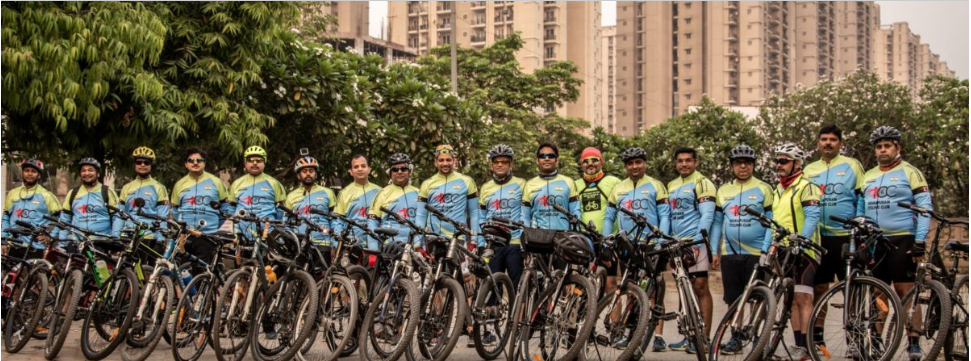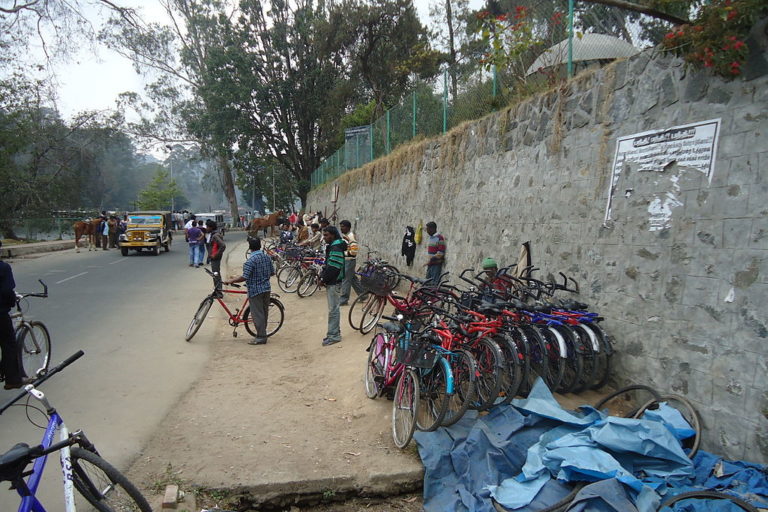
- A recent study by TERI estimated that if bicycles substitute two-and four-wheelers used for short-distance trips in India, it can result in an annual benefit of Rs. 1.8 trillion. However, the absence of a cycling ecosystem is preventing it from becoming the preferred mobility solution for all sections of society.
- The study also recommended bicycles for low-income households, for income-generating activities, cost-effective mobility and uplifting the socio-economic condition of women. But the high price of bicycles and lack of financing options is preventing this from happening.
- The government is trying to promote cycling in cities, specially those under the Smart Cities Mission. But experts state that India is not ready yet and advocate for a series of policy actions to make it a reality.
Forty-year-old Sudipto Roy working in a multinational firm in Delhi tried cycling to his office, nearly 22-km away from his home, instead of using his car, but gave up the idea after a few times. Subhash Kumar, 45, an electrician working in the same area, relies only on his bicycle for his commute.
The lack of a cycling ecosystem and infrastructure in India prevent many urban citizens like Roy from switching to this ecofriendly mode of transport. Meanwhile, several like Kumar, who have no access to other mobility options, continue to pedal away on challenging city roads that are not set up for a cycling culture. But the case for making cycling a go-to mobility solution for people of all sections in the society recently got stronger with research proving that a shift to cycling, even for short-distance trips, in densely populated and polluted Indian cities and towns can result in savings of over a trillion rupees.
The fact was emphasised in a study released by The Energy and Resources Institute (TERI) in January 2019 which estimated that if bicycles were to “substitute the two- and four-wheelers used for short-distance trips, it can result in an annual benefit of Rs. 1.8 trillion, which is equivalent to 1.6 percent of India’s annual GDP for 2015–16.”
Roy, who lives in Ghaziabad in Uttar Pradesh, part of the national capital region, uses his car daily to cover a 22-km distance to his office in Delhi. “Last year, I tried cycling several times to commute to the office but shifted back to the car even when cycling meant monetary and health benefits due to lack of overall system. Now it has just become a weekend activity,” he said.
In addition to the lack of an ecosystem for cyclists, Roy highlighted several other factors like the mindset of motorists for whom “cyclists are invisible”, dirty roads that become a safety issue and unreliable emergency services, which have prevented him and many others like him from choosing to switch to cycling.
However, there are millions in India who do not have the economic means or easy access to public transport and have to either rely on cycles or walk to their workplaces. They face the same challenges that are discouraging Roy to take up cycling and have succumbed to living with them. For instance, Subhash Kumar’s bicycle, was stolen twice in the past few years, a common occurrence for many who do not have a safe parking spot for their cycles. Making barely Rs. 20,000 a month, Kumar bought used bicycles as he could not afford a two-wheeler or public transport for his daily commute. Everyday he faces the problems that Roy highlighted — insensitive motorists, dirty roads and the danger of no medical help in case of an accident.

Sudipto Roy during one of his weekend cycling trips. Photo provided by Sudipto Roy.
The dangers expressed by both Roy and Kumar were reality for Sunita Narain, who is the director general of the Centre for Science and Environment, a Delhi based think tank working on environmental issues. In 2013, she suffered multiple fractures and got severe injuries when she was hit by a car while cycling one morning.
Narain said that “India is just not ready for cycling yet.”
“We have to remember that vast number of Indians cycle in our cities because they are too poor even to take a bus. They are invisible users and we do not think about them. We are still very car-centric inspite of all the talk. The only place in Delhi where we can cycle is the Lutyens’ Delhi where the rich people live who will never take a cycle in their life,” Narain told Mongabay-India.
Saving money with cycling
More than 50 percent of the people in India use non-motorised forms of transport, such as walking and cycling, to travel to work, followed by two-wheelers (18 percent) and buses (16 percent), according to the TERI study, “Benefits of cycling in India: An economic, environmental, and social assessment”, which was supported by the All India Cycle Manufacturers’ Association.
“In urban and rural India, on-foot trips account for the highest share of work trips with the share being 12 percent higher in rural areas. In rural areas, for meeting the daily travel requirements, workers are most dependent on cycling after walking. However, in urban areas, after walking workers are most dependent on two-wheelers,” the study said.
The study revealed that in the last decade, the number of total registered motor vehicles in India has grown from 89 million vehicles in 2006 to 230 million in 2016. “This trend has been spearheaded by the unprecedented rate of urbanisation and population growth in India,” the study emphasised.

For millions in India, a cycle is the cheapest and only option to go to work. Photo by Khusbu3/Wikimedia Commons.
The TERI study quantified the direct and indirect benefits of increased cycling, indicating billions of rupees in savings from every benefit of cycling ranging from improvement in personal health, increase in personal fuel savings to energy security, a reduction in emissions/air pollution, time-travel savings and reduced inequality. The savings from increased physical activity itself is valued at over Rs. 1.4 trillion for accumulated benefits over 15 years.
“Large-scale substitution of motorised private transport by cycling can also reduce noise pollution, improve road safety, and provide recreational value to users,” said the study while stressing that it will also address the burgeoning energy import bill.
It also suggested that cities should plan “city-wide bicycle-sharing schemes instead of only focusing on specific locations” and that there should be regulations “on the use of private motorised vehicles, such as congestion and parking pricing and pollution tax” to encourage cycling.
For low-income households, the study said a bicycle can be “an invaluable asset used for multifarious income-generating activities, a cost-effective form of mobility and can positively impact the socio-economic condition of women” while recognising that bicycle ownership remains low in this segment because of high price of bicycles and lack of financing options.
To address these issue, the study suggested the provision of microfinancing options and implementation of cycle-distribution schemes should be undertaken.
“Given that at present the expenditure on bicycles accounts for a large share of household income, it is important to make bicycles more affordable for low-income households. This could be achieved by reducing the GST rate on bicycles costing less than Rs. 5,000 from the existing 12 percent to the lowest rate of five percent,” said the study.
It also recommended that a ‘Bicycle Development Council’ should be established for the growth and development of the sector in India.
The TERI study was released at an event attended by Union Commerce and Industry Minister Suresh Prabhu and Union Minister of State for Water Resources Arjun Ram Meghwal. Meghwal is known for his love for cycling and has been often seen cycling from his official bungalow in Delhi’s VIP Lutyens zone to the Parliament.
Cycling can solve India’s urbanisation issues
With an upcoming boom in urbanisation expected over the next two decades and millions of people moving to cities, it is key to formulate a well-planned strategy at this time to prepare for the future.
Avid cyclist Faisal Thakur, who is well known in Mumbai for inspiring thousands to start cycling, feels what India needs is a change of mindset not only among cyclists but in motorists and policymakers as well.
“We are short of (cycling) infrastructure but it would be very selfish to ask for cycling tracks in already existing congested roads. It doesn’t make sense. What we need is a good mindset in people – that when they see cyclists, they give way to them and also keep them safe on the road. These are the small things which will make a difference,” Thakur told Mongabay-India.
“But if you are creating a new city you can plan a track for cycles so that you are not sharing the road with someone or in other terms, not taking away someone else’s space. It should be implemented from the set-up stage only (in the smart city projects). Because if the infrastructure is there then it gets easier for newbies to join,” he explained.
Thakur, however, warned that any development to promote cycling which is not backed by all authorities would backfire. He recounted an example of Mumbai where there was no support from authorities in ensuring that a newly built cycle track remains free from encroachment and motorised vehicles.

For many dedicated cycling tracks can be a considerable factor in adopting cycling on large-scale. Photo by Ranjithsiji/Wikimedia Commons.
With the central government’s initiatives to develop smart cities across India, cycling has also found a way back into focus in policy making.
State governments and municipal corporations in proposed “smart cities” across the country, like Pune, Thane, Bhopal and others are working towards including cycling in the broader development plan for the city. Perhaps the only thing that is needed is for different sections of the governments to work together and develop a comprehensive national policy.
Banner image: The TERI report states that cycling can result in an annual benefit of Rs. 1.8 trillion. Photo by Sudipto Roy.
First published by Mongabay on 25 Jauary, 2019